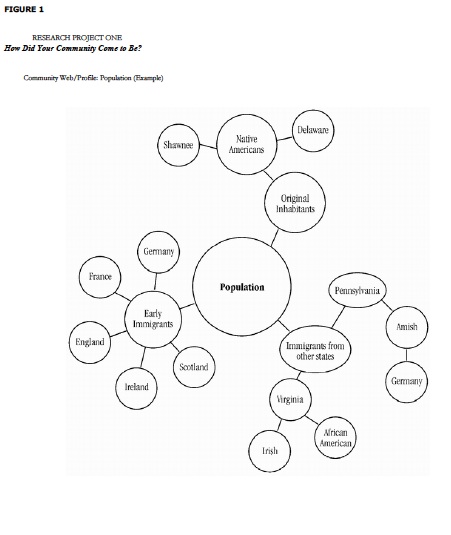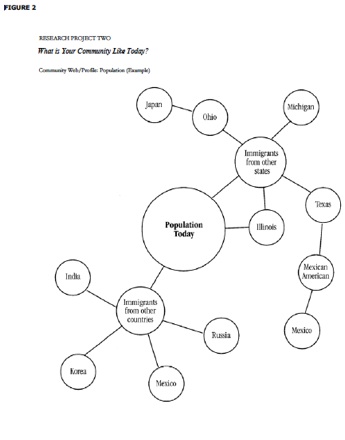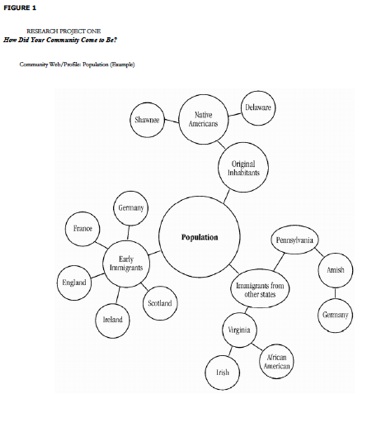
World in Community

LESSON DESCRIPTION
This is an extensive lesson or series of lessons intended to engage students in a research project that explores their community's international connections in both the past and the present. It might be used as part of a United States history course, as a community studies project, or in conjunction with a service-learning initiative (see Lesson 3). International relationships can be found in a number of aspects of community life, including community history, population, business and industry, religious groups, educational institutions, and cultural organizations. After researching several of these topics, students pool their information to develop a community profile or web, which shows how their community is linked to the world. If a long-term project of this type is not feasible for your classroom, students might choose to explore just one of the two research topics or just one of the sub-topics (such as "education," "businesses," or "population").
OBJECTIVES
As a result of this lesson, students will be able to:
1. Find their community on local, state, national, and world maps and speculate about the reasons it is located where it is;
2. Examine their community's early history, including the community's name, early inhabitants and settlers, businesses and industries, landmarks, and cultural institutions;
3. Analyze international connections in various aspects of community life, including population, education, business and industry, religious activities, traditions, festivals, and cultural events;
4. Construct a community web or profile summarizing what they have learned about international relationships in their community.
KEY IDEAS
Location. Both the exact position of a place on the earth's surface and its location in relation to other places.
Place. The physical and cultural characteristics that make a place unique or different from other places.
Culture. Culture consists of interrelated networks of ideas that are learned, shared, and constantly modified by a group of people.
Among these complex networks are language, religion, customs, and artistic expression. Culture allows humans to adapt to their environment and is always in the process of change in response to new conditions and ideas. For this reason, there is considerable variation within any cultural system. Most modern nations are made up of a variety of cultures that interact with and influence one another. In fact, most individuals are probably part of several cultures. Our individual thinking and behavior are influenced by culture, whether we are aware of it or not. Ethnic group. People who share a common cultural background and ancestry. Continuity , and change. These are key concepts in historical studies. It is important for students to understand that things change constantly, but it is also important to recognize the continuation of ideas, places, traditions, institutions, etc.
TIME REQUIRED
One to three weeks
MATERIALS
• Local, state, national, and world maps (pages 37-38)
• Local and community histories
• Local phone books and directories
• Tourist brochures about your area or community
• Figure 1: Community Web/Profile for Research Project One
• Figure 2: Community Web/Profile for Research Project Two
• Handout 1: Did You Know? Cards
• Flip charts or chalkboard
-
•Large sheets of paper for community webs or profiles
PROCEDURES
1. Ask students to locate their school on a local map and their community on a state map, United States map, and world map. Have them place a dot or sticker on the world map indicating the location of their community. (If your school is not located in an established community, have students choose a nearby community that they know.)
2. Divide the class in half to carry out investigations of Research Projects One and Two. Then form pairs or small groups to study the various sub-topics listed.
-
3.Have each group create a graphic representation of its findings in the form of a Community Web/Profile (see Figure 1 and Figure 2 for examples). For maximum value, have each group create its own unique web, rather than copy the examples..
RESEARCH PROJECT ONE
Ask students to consider the question How did your community come to be? Have small groups of students
research the following topics:
-
A.When and why was your community established in its particular place?
-
B.How did your community get its name, and what is its significance? Is your community named after a person? If so, who was this person, and why was he or she important? Some communities are named after places in other countries or have names that come from different languages or cultures. If this is the case with your community, what is the meaning or origin of its name? Some communities changed their names at some point in the past. If your community did so, what was the reason? Use a state map to find communities throughout Indiana with names that have come from other countries.
-
C.Who were the original inhabitants of the area? Who were the early settlers in the community, and where did they come from? Were any of these settlers immigrants from other countries? What cultural groups and countries influenced the early development of your community? What languages were important? As time went on, what additional groups of people moved to your community? Where did they come from, and what contributions did they make?
-
D.What kinds of businesses and industries existed in the early days of your community? What did they produce? Where did raw materials come from, and where did finished products go? Where did the owners and workers come from?
-
E.What cultural, educational, and religious institutions did your community have early in its history? Whatimportant historical buildings or other historical sites still exist today?
RESEARCH PROJECT TWO
Have students research the question What is our community like today?
A. Describe the population: Are people from other places moving to your community? Is the population much as it was in the past, or is it changing? What are the various cultural groups in your community? Why do people from these groups move to your community? Interview someone who has recently arrived to your community from
another country.
-
B.What businesses are in your community? What connections do they have to other parts of the world? What products do they buy (import) from other countries or sell (export) internationally? What skills and knowledge do the workers in these businesses need to have to be successful?
C. What religious groups are in your community? What international activities are part of their programs? Many congregations are involved in educational, charitable, and other international efforts. Many also have historical and cultural links to other parts of the world. Some may host visitors and speakers from other countries or
congregation members who have traveled to other countries may report on their visits. (One way to approach this topic is to have students survey their own religious groups.)
D. What educational institutions (e.g., public and private schools, colleges or universities) are in your community? What international contacts do they have? Do they have students, teachers, or families from other countries? Do they have sister schools in other countries? Do they have international houses? Do they sponsor international
exchanges or cultural events?
E. What traditions, festivals, or cultural events in your community are linked to other cultures or other parts of the world?
-
F.Does your community have a sister city in another country? Name and locate that city.
Source: Sister Cities International website, http://www.sister-cities.org
CLOSURE
Post each group's web or profile where it can be seen by the class. Ask students to discuss what they have learned from their respective research projects. Ask students what the two research projects indicate about what has changed and what has remained the same in their community over time. What international connections have they discovered? Do they see their community differently after doing the research project? If so, how? If not, why not? Have students take turns summarizing the discussion using flip charts or the chalkboard to record important things that have changed, things that have not changed, and the various cultures and regions of the world that have connections to the community.
ASSESSMENT
Have students combine the community webs into one large web representing various aspects of the community and its links to the world.
EXTENSIONS/CONNECTIONS
-
1.As an alternative to constructing community webs, students might develop multimediapresentations, pamphlets, or travel brochures highlighting the international aspects of their community.
2. Use the community knowledge developed in this lesson as the basis of a service-learning project (see Lesson 3).
-
3.Have students develop their own Did You Know? Cards (see Handout 1) about the origins of various Indiana communities. Include information about how these communities celebrate their cultural heritage and international connections today.
-
4.Explore the international influences in the architecture of buildings in your community.
-
5.Explore international connections in your own school. Survey teachers and students to see how many have lived or traveled in another country. How many have friends or relatives in another part of the world?
6. Interview a foreign student. Students might interview a high school exchange student, an international college or university student, or a student in another country via e-mail. Invite an international student to visit the class as a guest speaker. Students should be prepared in advance with questions they would like to ask. They should also consider what it would be like to be an exchange student and to speak to a class full of students in a foreign country.
-
7.Explore opportunities for becoming an exchange student. A number of organizations provide information on foreign exchange experiences for high school and college-age students (see Global Education Resources).
8. Have students develop a website describing their own community (see information about Community Publishing Company in Resources).
RESOURCES
• County historical society
• Local chamber of commerce or tourist bureau
• Indiana Historical Bureau, 140 North Senate Avenue, Indianapolis, IN 46204-2296; http://www.statelib.lib.in.us/www/ihb/ihb.html
• Indiana Historical Society, 450 West Ohio Street, Indianapolis, IN 46202 http://www.indianahistory.org
• Historic Landmarks Foundation of Indiana, 340 West Michigan Street, Indianapolis, IN 46202-3269; http://www.historiclandmarks.org
• Taylor, Robert M., Jr. and Connie A. McBirney (eds.). Peopling Indiana: The Ethnic Experience. Indiana Historical Society, 1996. This volume is an extensive study of the peoples that have populated Indiana in the past and present. It is an excellent teacher resource.
• Baker, Ronald Y and Marvin Carmony. Indiana Place Names. Bloomington: Indiana University Press, 1976. (This book is out of print but may be available at libraries.)
• For information on student exchange programs, see Global Education Resources.
• The Community Publishing Company, a series of publications of EconomicsAmerica available from the Indiana Council for Economics Education, 1145 Smith Hall, Purdue University, West Lafayette, IN 47907-1145; tel. 765.494.8545. http://www.bsu.edu/econed/cpc/index.html
-
•Who Do You Think We Are? Video by the Indiana Historical Society, 450 West Ohio Street, Indianapolis, IN 46202-3269.
DID YOU KNOW? CARDS
DID YOU KNOW?
Vincennes is the oldest community in Indiana. It was established as a French fort in the early 1730s by Sieur de Vincennes. In 1800, the non-Indian population in and around the town was 1,533. Vincennes was the capital of the Indiana Territory from 1800 to1813.
Source: The Indiana Historian, March 1999.
DID YOU KNOW?
The city that we know today as Fort Wayne was originally a large Miami Indian community named Kekionga. Its location, where several rivers join near the Great Lakes, made it an important regional center for Native American trade and culture.
Source: In the Presence of the Past: The Miami Indians of Indiana, Eiteljorg Museum of American Indians and Western Art, Indianapolis.
DID YOU KNOW?
On September 3, 1811, Mrs. Lydia Bacon, the wife of a U.S. army officer, traveled with her husband and his regiment down the Ohio River through the town of Vevey in what is now Switzerland County. She made the following entry in her diary: "About 30 (Swiss) families had taken up their residence here . . . have planted Vineyards . . . Their wine made from the Maderia & Clarret Grapes is excellent. We purchased some. This place is called Veva, it is in New Swiss."
Source: The Indiana Historian. March 1999.


